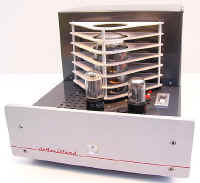
JazzTimes
America's Jazz Magazine
Sound Advice / Audio Video Files
Date: September 2005 Issue
Written By: Mike Quinn
deHavilland GM70 Amplifier review...

After hearing Kara Chaffee’s amazing deHavilland GM70 amplifiers ($9,995/pair/dehavillandhifi.com) at the Consumer Electronics Show last January, I knew I had to have them in-house for a proper evaluation. The amps (these are monoblocks, meaning there is a separate amp for the left and right channels) possess an uncanny magic that it seems only single-ended tube amplifiers can produce—that is the ability to reproduce music in a startlingly realistic fashion. Now, when I say startling, that is not an exaggeration. The GM70s repeatedly caught me off guard with their faithfulness to the music, producing goosebumps during many of my listening sessions. Passing this goosebump test puts the GM70s in a rarified league indeed. They offer immediacy and resolution in spades, but more importantly, transmit the emotional content of a performance in a way very, very few amplifiers can.
Briefly, a single-ended amplifier uses only one tube to power each speaker (some designs use as many as eight per channel) so the musical signal remains more coherent. These particular amps are designed around the GM70 tube which was developed for use in Soviet tanks guaranteeing durability and a long life. In addition, Chaffee chose this tube because it is capable of producing more power, in this case 50 watts, than typical single-ended designs which use less potent ‘glass’ and are characteristically lower powered, normally ranging from three watts to somewhere in the mid teens. Chaffee’s intent has always been to produce single-ended amps with enough power to drive the ‘real world’ speakers most of us own.
Well, not only were the GM70s able to power any of the speakers I had on hand, but they did so in a fashion that kept me riveted to my listening chair. Music came alive, was vibrant and had all the punch of live music, but also finessed the delicate pianissimo details where needed. It was as if I had a very powerful lens to view the music, everything crystal clear and every nuance in perfect focus, and always plenty of muscle to spare—even during loud passages they never even broke a sweat. Bass was not sloppy or bloated, but tight and rhythmic. The mids were clear as a bell, and the highs present and accounted for, not rolled off as with many tube components.
On the delightful Jumpin’ With Al by the brilliant, but overlooked guitarist Al Casey, the sensation of being in the studio was stunning. All the space around the instruments was apparent, the resonance and decay of the bass, the drums, the guitar followed each attack in a way normally experienced with live performers, or with audio gear of this caliber. The unique qualities of Casey’s amplified acoustic guitar came through loud and clear. (Guitarists should check out this guy for sure.)
Geri Allen’s recent The Life of a Song is an artistic tour de force with Jack DeJohnette and Dave Holland as side men. The deHavillands placed all their rhythmic verve on Holdin’ Court upfront and center. Allen’s piano was rich, full and rock solid in timbre, just like a real piano. Her thick chords and complex runs were all perfectly defined and discernable, not messy globs of sound as some systems might have you believe.
The deHavilland GM70 is a work of art, no question about it. My original assessment of these jewels was correct: they make music as few other amplifiers can, do so pristinely, and make listening an absolute joy.